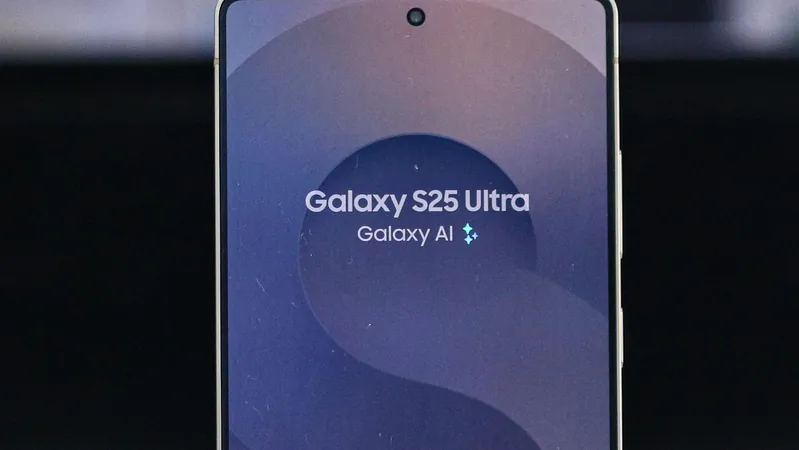
Breakthrough in Diamond Semiconductors: A New Era for Quantum Devices and Biosensors
2025-01-20
Author: Jacques
In an exciting development for the world of technology, researchers have unveiled groundbreaking properties in diamond semiconductors, specifically through the introduction of boron doping. This innovation not only enhances the traditional applications of diamonds in electronics and optics but also opens doors to revolutionary biomedical devices.
A collaboration between Case Western Reserve University and the University of Illinois Urbana-Champaign has resulted in significant findings regarding boron-doped diamonds, which were recently published in *Nature Communications*. These findings highlight the material's ability to exhibit plasmonic properties—an astonishing capability that allows it to manipulate electric fields on a nanometer scale when illuminated.
Quantum Advancements and Beyond
The implications of this discovery are vast, promising advancements in various high-tech fields, including quantum computing, advanced biosensors, and solar energy technologies. Unlike metals, which often lose transparency when doped, boron-doped diamonds maintain their optical clarity, thus offering dual functionality in applications where visual and electronic properties are both necessary.
Giuseppe Strangi, a professor of physics at Case Western Reserve, expressed enthusiasm for this breakthrough, stating, “Diamond continues to shine both literally and as a beacon for scientific and technological innovation. As we advance into the era of quantum computing and communication, discoveries like this are pivotal.” Meanwhile, Mohan Sankaran, a professor in nuclear, plasma, and radiological engineering, emphasized that "understanding how doping affects the optical response of semiconductors like diamond reshapes our knowledge of these critical materials."
Plasmons and Their Historical Context
What makes plasmonic materials so compelling? These materials interact with light at a nanoscale, creating waves of electrons that enhance certain optical properties. Historically, humans have marveled at this effect; for example, the rich colors in medieval stained glass emerged from metal nanoparticles that interact with light—showcasing a vivid representation of this science long before its exploration.
The method of creating boron-doped diamonds involves carefully introducing boron—an element adjacent to carbon in the periodic table—into the diamond lattice. This process results in a transparent material often imbued with a blue hue, as famously seen in the Hope Diamond.
The Future of Biomedical Applications
The unique characteristics of boron-doped diamonds make them a promising candidate for use in high-sensitivity biochips and medical imaging technologies. Their chemical inertness and biocompatibility suggest they could be used in environments where traditional materials fail, bolstering our ability to conduct precise medical diagnostics and therapies.
A Legacy of Innovation
This research continues the legacy initiated in 1968 by John Angus at Case Western Reserve, who pioneered low-pressure synthetic diamonds and was the first to identify the electrical conductivity of boron-doped diamonds before his passing in 2023.
As the world gears up for a future heavily reliant on quantum devices and highly sensitive biomedical instruments, the advancements in diamond semiconductor technology are set to play a transformative role. With ongoing research and exploration, we may soon witness a revolution in how we interact with these extraordinary materials.
Stay Tuned!
Stay updated as we explore more on how these discoveries will continue to change the landscape of technology and medicine, bringing us closer to a remarkable future!









 Brasil (PT)
Brasil (PT)
 Canada (EN)
Canada (EN)
 Chile (ES)
Chile (ES)
 Česko (CS)
Česko (CS)
 대한민국 (KO)
대한민국 (KO)
 España (ES)
España (ES)
 France (FR)
France (FR)
 Hong Kong (EN)
Hong Kong (EN)
 Italia (IT)
Italia (IT)
 日本 (JA)
日本 (JA)
 Magyarország (HU)
Magyarország (HU)
 Norge (NO)
Norge (NO)
 Polska (PL)
Polska (PL)
 Schweiz (DE)
Schweiz (DE)
 Singapore (EN)
Singapore (EN)
 Sverige (SV)
Sverige (SV)
 Suomi (FI)
Suomi (FI)
 Türkiye (TR)
Türkiye (TR)
 الإمارات العربية المتحدة (AR)
الإمارات العربية المتحدة (AR)